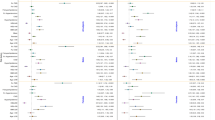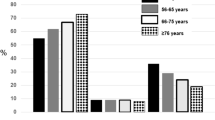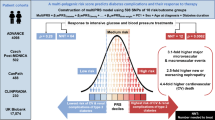Abstract
Fibrillin-1 (FBN1) was reported to have impact on the physiological arterial stiffness and vascular remodeling with hypertension of recent years. In the previous study we reported the association of four functional single nucleotide polymorphisms (SNPs) of FBN1 gene and hypertension. Here, we further investigate the association of four tagging SNPs (tagSNPs) which covered remain genetic variation blocks of FBN1 gene with hypertension, blood pressure and efficacy of antihypertensive in a South Han Chinese population. A case–control study including 2,012 hypertension cases and 2,116 controls age- and sex-matched controls was conducted from a community-based population and four candidate tagSNPs of the FBN1 gene were genotyped. Association analysis by multiple logistic regression was conducted for allele, genotype and haplotype and hypertension, blood pressure trait and control status with antihypertensive. General linear model was applied to compare blood pressure levels between genotypes. The association of rs17361868 and hypertension was statistically significant and that was further observed in female, ≥55 years, non-smoking and non-drinking populations (P < 0.05). Significant association of rs668842, rs11635140 and hypertension were observed in <55 years population as well as the later in female and non-smoking populations respectively. Haplotype G-T constructed of rs668842 and rs11635140 was significantly associated with hypertension comparing to reference haplotype A-C (P = 0.022). Normally distributed square root of TGF-β1 (pg/ml) of hypertension cases (148.56 ± 66.46) was significantly higher than that of control (128.52 ± 65.11), P = 0.008. Furthermore, TGF-β1 was significantly correlated with SBP (r = 0.135, P = 0.018) and DBP (r = 0.154, P = 0.007) respectively whereas no statistical difference of blood pressure or TGF-β1 was observed between genotypes. Remarkably, rs17361868 were significantly associated with the status of blood pressure in the patients taking three of the antihypertensive drugs, Zhen Ju Jiang Ya tablets, Jiang Ya tablet and compound reserpine (P < 0.05). The present study provides further association evidence of FBN1 gene polymorphisms and hypertension, antihypertensive efficacy. Further replication of these results via association or prospective studies conducted in other populations is warranted.
Similar content being viewed by others
References
Kannel WB (1993) Hypertension as a risk factor for cardiac events—epidemiologic results of long-term studies. J Cardiovasc Pharmacol 21(Suppl 2):S27–S37
Schiffrin EL (2004) Remodeling of resistance arteries in essential hypertension and effects of antihypertensive treatment. Am J Hypertens 17(12 Pt 1):1192–1200
Et-Taouil K, Safar M, Plante GE (2003) Mechanisms and consequences of large artery rigidity. Can J Physiol Pharmacol 81(3):205–211
Laurent S et al (2001) Aortic stiffness is an independent predictor of all-cause and cardiovascular mortality in hypertensive patients. Hypertension 37(5):1236–1241
Kingwell BA (2002) Large artery stiffness: implications for exercise capacity and cardiovascular risk. Clin Exp Pharmacol Physiol 29(3):214–217
Kielty CM, Sherratt MJ, Shuttleworth CA (2002) Elastic fibres. J Cell Sci 115(Pt 14):2817–2828
Sherratt MJ et al (2001) Fibrillin-rich microfibrils of the extracellular matrix: ultrastructure and assembly. Micron 32(2):185–200
Kielty CM et al (2002) Fibrillin-rich microfibrils: elastic biopolymers of the extracellular matrix. J Muscle Res Cell Motil 23(5–6):581–596
Sterzel RB et al (2000) Elastic fiber proteins in the glomerular mesangium in vivo and in cell culture. Kidney Int 58(4):1588–1602
Intengan HD et al (1999) Resistance artery mechanics, structure, and extracellular components in spontaneously hypertensive rats: effects of angiotensin receptor antagonism and converting enzyme inhibition. Circulation 100(22):2267–2275
Agrotis A, Kalinina N, Bobik A (2005) Transforming growth factor-beta, cell signaling and cardiovascular disorders. Curr Vasc Pharmacol 3(1):55–61
Dietz HC et al (1991) Marfan syndrome caused by a recurrent de novo missense mutation in the fibrillin gene. Nature 352(6333):337–339
Sinha S et al (2002) Expression of latent TGF-beta binding proteins and association with TGF-beta 1 and fibrillin-1 following arterial injury. Cardiovasc Res 53(4):971–983
Ramirez F, Sakai LY (2010) Biogenesis and function of fibrillin assemblies. Cell Tissue Res 339(1):71–82
Zhao D et al (2010) Association of the TGF-beta1 gene polymorphisms and blood TGF-beta 1 level with essential hypertension in Kazakh Chinese. Zhonghua Yi Xue Yi Chuan Xue Za Zhi 27(4):463–468
Munger JS, Sheppard D (2011) Cross talk among TGF-beta signaling pathways, integrins, and the extracellular matrix. Cold Spring Harb Perspect Biol 3(11):a005017
Machado RD et al (2006) Mutations of the TGF-beta type II receptor BMPR2 in pulmonary arterial hypertension. Hum Mutat 27(2):121–132
Shen C et al (2011) Novel genetic variation in exon 28 of FBN1 gene is associated with essential hypertension. Am J Hypertens 24(6):687–693
Perloff D et al (1993) Human blood pressure determination by sphygmomanometry. Circulation 88(5 Pt 1):2460–2470
Lake SL et al (2003) Estimation and tests of haplotype-environment interaction when linkage phase is ambiguous. Hum Hered 55(1):56–65
Davis MR, Summers KM (2012) Structure and function of the mammalian fibrillin gene family: Implications for human connective tissue diseases. Mol Genet Metab 107(4):635–647
Robinson PN et al (2002) Mutations of FBN1 and genotype-phenotype correlations in Marfan syndrome and related fibrillinopathies. Hum Mutat 20(3):153–161
Lemaire SA et al (2011) Genome-wide association study identifies a susceptibility locus for thoracic aortic aneurysms and aortic dissections spanning FBN1 at 15q21.1. Nat Genet 43(10):996–1000
Carta L et al (2009) Discrete contributions of elastic fiber components to arterial development and mechanical compliance. Arterioscler Thromb Vasc Biol 29(12):2083–2089
Saltis J, Agrotis A, Bobik A (1992) TGF-beta 1 potentiates growth factor-stimulated proliferation of vascular smooth muscle cells in genetic hypertension. Am J Physiol 263(2 Pt 1):C420–C428
Li B et al (1999) TGF-beta1 DNA polymorphisms, protein levels, and blood pressure. Hypertension 33(1 Pt 2):271–275
Park HC et al (2009) Urinary TGF-beta1 as an indicator of antiproteinuric response to angiotensin II receptor blocker in proteinuric renal diseases. Biomed Pharmacother 63(9):672–678
Liu Z, Huang XR, Lan HY (2012) Smad3 mediates ANG II-induced hypertensive kidney disease in mice. Am J Physiol Renal Physiol 302(8):F986–F997
August P, Suthanthiran M (2006) Transforming growth factor beta signaling, vascular remodeling, and hypertension. N Engl J Med 354(25):2721–2723
Quarto N et al (2012) Exogenous activation of BMP-2 signaling overcomes TGFbeta-mediated inhibition of osteogenesis in Marfan embryonic stem cells and Marfan patient-specific induced pluripotent stem cells. Stem Cells 30(12):2709–2719
Wolf G et al (1998) Regulation of glomerular TGF-beta expression in the contralateral kidney of two-kidney, one-clip hypertensive rats. J Am Soc Nephrol 9(5):763–772
Acknowledgments
This work was supported by the National Natural Science Foundation of China (Nos. 81273165, 30800947 and Grant No. 81072367), the Natural Science Foundation of Jiangsu Province (No. BK2011776), Science & Technology Program of Wuxi (Nos. ZD1011 and CSEW1N1112) and the Priority Academic Program for the Development of Jiangsu Higher Education Institutions (Public Health and Preventive Medicine). The funders had no role in study design, data collection and analysis, decision to publish, or preparation of the manuscript.
Author information
Authors and Affiliations
Corresponding authors
Additional information
Jinfeng Chen, Song Yang and Xianghai Zhao have equally contributed to this study.
Electronic supplementary material
Below is the link to the electronic supplementary material.
Rights and permissions
About this article
Cite this article
Chen, J., Yang, S., Zhao, X. et al. Association study of common variations of FBN1 gene and essential hypertension in Han Chinese population. Mol Biol Rep 41, 2257–2264 (2014). https://doi.org/10.1007/s11033-014-3078-9
Received:
Accepted:
Published:
Issue Date:
DOI: https://doi.org/10.1007/s11033-014-3078-9




